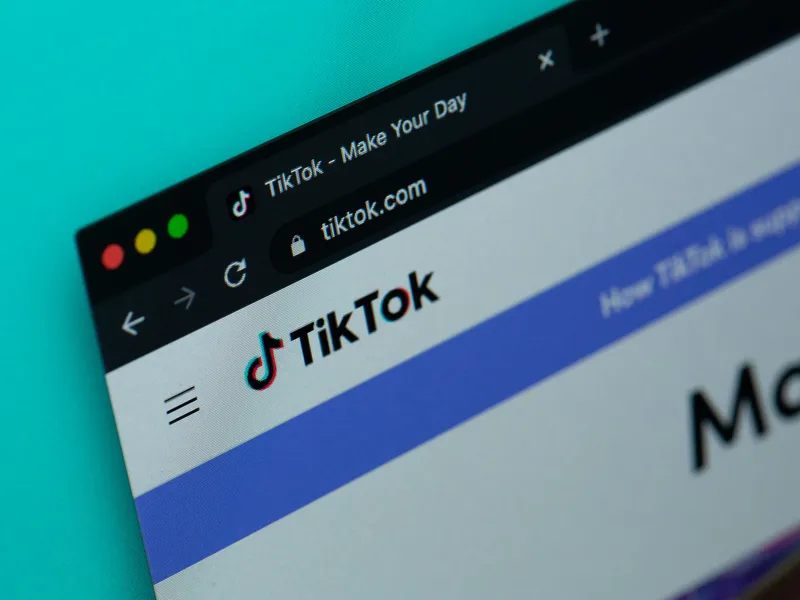If you’re promoting your business in 2025, you have countless tools that you can consider using. Arguably, one of the most powerful tools in your arsenal is social media. Use this to interact and engage with your audience, gaining the right level of attention for your brand.

Source: Unsplash CC0
As well as posting on social media, you can explore using Ads. With social media ads, you can promote your brand, products and services directly to the right target audience. One of the most popular social networks today is easily TikTok.
The latest figures suggest TikTok has more than 2 billion active monthly users with this number expected to grow to 2.25 by 2027.
To gain the most from your TikTok ad campaign, you need to ensure that you are using TikTok pixel integration. If you're just getting started, check out our guide to Set Up TikTok Pixel for beginners.
What is The TikTok Pixel?
The TikTok Pixel is a code snippet business owners can add to their website. This allows them to track the performance and success levels of their TikTok ads. You can even monitor conversion rates of different ad campaigns. For Shopify store owners, implementing a conversion pixel Shopify setup is essential for tracking your ecommerce success.
Why TikTok Pixel Matters for eCommerce in 2025
If you are running an ecommerce store in 2025, it’s essential that you take steps to ensure your campaign is both efficient and effective. If you are spending money on ads without seeing the necessary ROI, then this will add to risk to your business model.
With the TikTok Pixel, it is possible to track the performance of ads. Business owners can use this to monitor and adjust their campaigns where necessary, ensuring that they always reach the highest performance standards. This will also allow business owners to achieve the greatest possible ROI.
Here are some of the key reasons why this matters.
Boost Ad Targeting
Using the pixel, you can access data which will help you understand which users are more likely to convert from your ads in future campaigns.
Campaign Optimisation
Discover which ads are performing the best and optimise those which are falling short to gain better results overall.
Traffic Insights
Learn which ads on your site are driving traffic or generating conversions and which ones are not performing well at all. This allows business owners to focus on the right ads in the future and potentially pause campaigns that are not providing results.
Retargeting
Using data from the pixel, business owners can set up retargeting ads to create custom audiences based on website activity. This allows advertisers to retarget users who have previously interacted with their website.
Data Decisions
The pixel provides the opportunity to run marketing strategies through data decisions, offering insights regarding ad spend and overall campaign strategies.
User Behavior
By tracking ads using the pixel, business owners can also understand user behavior including how and when users interact with their website after clicking on a TikTok ad.
Key Features & Events Tracked by TikTok Pixel
Using the Pixel, business owners can track both standard and custom events. Events are actions that are taken on a website once a user clicks through from an ad. This could include adding an item to a cart or making a purchase. Let’s explore the different possibilities here and how both could benefit your business in the future.
Standard Events
Standard events are predefined actions that advertisers can track and then send to TikTok for reporting, optimisation, audience building or retargeting. Here is a list of the standard events available when setting up your ads.
- Add Payment Info - When a visitor adds paymention information during the checkout process
- Add to cart - when a visitor clicks on your cart
- Add to wishlist - when a visitor adds an item on their wishlist
- Application approval - When an application submitted by a user is approved as part of your business process
- Complete registration - When a visitor signs up for something like an account registration
- Contact - when a visitor contacts you directly
- CustomizeProduct - When a visitor customises a product
- Download - when a visitor downloads something from your website
- Initiate checkout - When a visitor proceeds to the checkout
- Lead - when a visitor submits a form
- Purchase - when a visitor completes a purchase
- Schedule - when a visitor to your website schedules an appointment
- Search - When a visitor completes a search
- Start trial - When a customer begins a free trial for a product or service
- Submit application - When someone decides to submit an application
Subscribe - When a visitor subscribes on your website - View content - When a visitor views a specific piece of content on your website.
Custom Events
As well as providing the option to track standard events, you can use the TikTok pixel to set up custom events. These are user-defined actions that extend beyond the predefined standard events list set by the application.
These can be managed using various methods such as the Event builder in Event Manager or directly through the web events API. Through custom events, business owners can access more detailed reports and optimise their audience creation.
Some of the benefits of custom events include:
- Flexibility through event tracking - Users can customize specific actions and track beyond set events.
- Enhanced audience targeting - custom events can be used to create precise audience segments
- Detailed reporting - detailed reports from custom events can be found in the ‘Event Type’ reporting column in both the Events Manager and TikTok Ads Manager.
Here is an example of the type of code that you can use to set up custom events on your website:
// For single product ttq.track('YourCustomEvent', { content_id: '301', content_type: 'product', content_name: 'dress', quantity: 1, price: 8, value: 9.2, currency: 'USD', }); // For multiple products ttq.track('YourCustomEvent', { contents: [ { content_id: '301', content_type: 'product', content_name: 'dress', quantity: 1, price: 8, }, { content_id: '401', content_type: 'product', content_name: 'dress', quantity: 1, price: 1.2, }], value: 9.2, currency: 'USD', })
How To Set Up TikTok Pixel in 2025
There are numerous options that you can explore when setting up Your TikTok Pixel in 2025. This includes:
- Manual Integration
- Automatic Shopify Integration
- TikTok Events API
Let’s explore each of these options in turn:
Manual Integration
To manually integrate your TikTok Pixel, you need to log into your TikTok Ads Manager. Once you have done this navigate to “Events” under “Tools”. Select “Manual Setup. Create a pixel name and copy the code provided pasting it into the header section of your site. Remember to create a backup version of your site before you make any changes like this. You can also explore using Google Tag Manager to ensure things are more orgnised.
Step By Step Guide:
-
Access TikTok Events Manager: Log into your TikTok for Business Ads Manager and go to "Tools," then "Events".
-
Connect Data Source: Click "Connect Data Source" and select "Web," then input your website URL.
-
Choose Manual Setup: Select "Manual Setup" as your connection method.
-
Create and Name your Pixel: Give your pixel a unique name, preferably corresponding to your website or domain.
-
Copy and Paste the Pixel Code: Locate the code provided by TikTok and copy it.
-
Install the Code: Paste the pixel code into the header section of your website's HTML.
-
Configure Events: Set up and configure the events you want to track, such as "View Content" or "Complete Registration".
-
Verify Installation: Use a tool like the TikTok Pixel Helper Chrome extension to verify that the pixel is properly installed and sending data. You may need to complete a test purchase to do so.
Automatic Shopify Integration
An easier way to use the TikTok pixel would be through automatic TikTok shopify integration.
To explore this option, you need to install the TikTok app on your shopify store. Once you have done this, you can then connect your TikTok for business account. After you have completed this step, choose your data sharing level. Options include standard, enhanced, and maximum data sharing.
The app will then automatically handle the installation of your TikTok pixel on your website. This is the easiest solution if you are running a Shopify website.
TikTok Events API (Advanced)
The TikTok events API allows advertisers and business owners to send web events from their servers directly to the TikTok app. The server-side events are linked to a pixel and then processed like browser pixel events. As the TikTok api integration is an advanced option it is advisable that you do consider using the support of a web developer to complete this step.
Best Practices for TikTok Pixel Integration
To ensure that you are getting the greatest possible results from your TikTok integration there are a few key steps you should take.
First, always regularly check the data collected by the Pixel and address any issues that you may have.
You might also want to start by using broader events. This is useful if you don’t have a lot of data to work with. Focus on options like page views and add to carts before moving onto conversions.
Finally, make sure that you are testing different creatives. Use AB testing to determine which type of ad works best for your audience.
Common Mistakes & How to Avoid Them
There are lots of different mistakes that you can make when you are setting up your TikTok Ads. Arguably, the easiest is to not copy the code directly. If you do this, then you run the risk of making a small error which will mean the integration doesn’t work at all. The easiest way to avoid this is to copy and paste the code directly on your website.
The other big mistake is not checking if the pixel is working. There are lots of different ways that you can do this. For instance, you might want to install a widget on your site. You can then complete a test purchase and determine whether your metrics are being tracked on your website.
Conclusion
Ultimately, TikTok provides a fantastic opportunity for business owners who are keen to expand their reach and access a larger target audience. This is particularly useful for businesses who are appealing directly to the 18-35 demographic which is often the case as these are the most active buyers on the market. The TikTok pixel integration provides an opportunity for business owners to understand how their ads are performing and whether or not they are providing the right results. Marketers can also gain deeper insights to build effective audience bases and understand how customers are interacting with your website. For professional TikTok pixel integration and tracking support, MultiPixels offers end-to-end setup and optimization.
FAQs
What does the TikTok Pixel actually track?
The TikTok Pixel is used to track a wide range of metrics including purchases, content interactions, checkout uses, signups, leads, and much more. This is far from an exhaustive list and with so many different possibilities it is worth considering which option is the right choice for your needs as a business owner. You can choose from both standard and custom events but they will not all be applicable to your business model.
Do I need coding knowledge to install the TikTok Pixel?
It is possible to explore TikTok pixel integration without any coding knowledge. However, it would be beneficial to have some understanding of where the provided code fits on your site. You will also find it easier to explore custom event tracking if you have knowledge of how to create different codes.
Can I install the TikTok Pixel without running ads yet?
Yes, it is possible to install the TikTok pixel without running any ads. You can install the code on your site even if you don’t have any active ads running.
Is the TikTok Pixel the same as Meta (Facebook) Pixel?
No, it is important to note that the TikTok Pixel and the Meta Pixel are not the same. However, they do share the same purpose, providing tracking options for business owners. The Meta Pixel tracks interactions that are linked to the Meta advertising platform.
How do I know if my TikTok Pixel is working properly?
To guarantee that the TikTok pixel is working correctly, you should use the TikTok pixel Helper Chrome extension to check for any potential errors. You can also test pixel events using the test events feature in the Events Manager of the TikTok ads platform.
Are you ready to Grow your Business?
Get started
